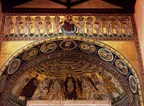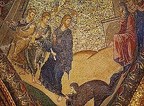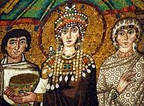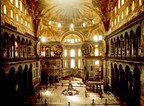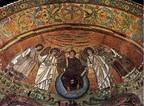The Roman Empire was divided into two parts, the Eastern and Western Roman Empires before it fell in 476 AD. Out of these two parts the “Western Roman Empire fell down in 476 AD. However, the Eastern Roman Empire did not fall and was miraculously saved to preserve the Roman culture. Constantinople was declared as the capital city and the Eastern Roman Empire became the Byzantine Empire. After that the development of the empire started. The first and foremost achievement of the Byzantine Empire was the construction of religious buildings with fabulous and charming designs. Among the other innovations, the most important was the development of basilicas. Basilicas were actually the churches developed just like early Christian or medieval churches. This was a unique style of Eastern Orthodox and Roman Catholic churches.
There existed a common trend of using the dome in Byzantine and Islamic architecture. This dome style was basically originated from Byzantine but later it was passed on to the Muslims and became a part of Islamic architecture. Dome of the Rock in Jerusalem is one such example. Mostly the “Persian’ dome was used. In this modern era this is referred to as the Onion Dome. One of the most famous examples of this Dome is the Taj Mahal at Agra, India. The Dome developed by Byzantine was a great achievement and as a result this advancement a new style in global architecture was produced. Before this neither such buildings were designed in this way nor did any civilization use this kind of style for their religious buildings. All this was done only by the Byzantines. This was the time when structural evolution took place in Byzantine art. Before this, only two main types of plan were used especially for churches. One was the basilica and the other was the circular or central. The former represented the Holy Sepulcher and the latter represented the great octagonal church at Antioch.
527-565 AD was The Golden Age of Byzantine architecture and this area was ruled by Justian. Hagia Sophia which is the most renowned example of Byzantine Architecture was built during this period. Unfortunately this church was destroyed by fire and rebuilt in 532 AD. This church was constructed using some unique style and features which later became a part of the Byzantine Architecture. The basic infrastructure of Hagia Sophia also known as Church of Wisdom included a huge dome in the center set on four pillars which were arranged in the form of a square. This gives the Dome a very unique look. During this era the Byzantine Empire was considered one of the most distinctive entities in artistic and cultural innovations. Its unique styles and designs also influenced the European architecture. In fact it was actually the Roman architecture which was extended to the Early Byzantine Architecture. After that in the seventh century, the Arabs invaded which resulted in the rise of Islam and a period started in which the symbolic icons or images of a society or religion were defamed. This duration in now known as ‘Iconoclastic Period’, a Greek word particularly used for “image-breaking”.
Before 1453 the Byzantine art and Architecture were famous for the generous use of gold and silver in artworks and building designs & styles. This practice continued up till the fall of Constantinople, the great capital in the fourth century. The Byzantine Empire depicts the Greco-Roman culture which flourished in the middle age. The Byzantine Empire is also known as Eastern Roman. Human figures were mainly the soul of this Byzantine art. For example, the holy Christian figures, “apostles,” “Virgin Mary,” and “saints”. “Angels & bishops” were also included in these nominated figures. The most imperative role was played by the emperors of the Byzantine to flourish the unique art and culture. However, this era faced a crucial conflict related to art and architecture between the Roman Catholic religion which was prevalent in the Western Roman Empire and the Eastern Orthodox religion which was present in the East. The Eastern Orthodox Church was valued for the delicacy of Byzantine artworks. The traditional heritage of this era was basically composed of images of “Cherubs”. The art of paintings was also promoted in that duration. The use of gaily colors like golden and dull backgrounds presented somewhat comatose and stressed figures. One of the examples of such mosaics is the “Hagia Sophia” present in Constantinople. The major theme of the Byzantine Art related to human figures consisted of two different styles. One of them was the symbol of authority and power which included the figures of saints and The Christ. These figures were presented in a very fascinating and noble style. The other style presented the some religious symbols like prayer etc.
During the fifth and sixth century, the Byzantine Art remained consistently at its peak. But during the eighth and ninth century, this art began to lose its value. The main reason was that the human figures were excluded from the paintings because the rulers considered this artwork to be a symbol of idol worship due to the presence of human figures. However, at the end of the ninth century the old Byzantine Art got its esteemed reputation back again. In the tenth and eleventh century, the Byzantine Art made its way to the Western Europe and after sometime became the most favored and valuable art. The Byzantine architecture was readily adopted by most of the European countries especially Italy. The magnificence of Byzantine art sustained up to the mid of the 14th century.
Later the Byzantine Empire focused on the Mosaic Art which reached to its climax within no time. The mosaics were specially ornamented and decorated with Jesus images. These mosaics were meant to be used for the church domes in various areas of the empire including churches in Athens and some other states.
